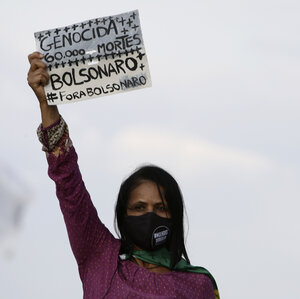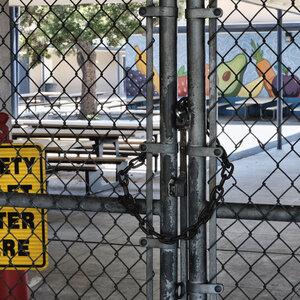People leave the Ocean 10 restaurant as a curfew from 8
p.m. to 6 a.m. is put in place on Saturday in Miami Beach, Fla.
Joe Raedle/Getty Images
Several U.S. states reported new record-breaking coronavirus case
counts over the weekend as the nationwide death toll from COVID-19
surpassed 140,000 and President Trump insisted again that the virus
would “disappear.”
States such as Florida, California and Kentucky were reporting
record or near-record numbers of new cases, and in Texas a hospital
official told NPR that funeral homes and morgues were overflowing from
the bodies of COVID-19 victims.
Meanwhile, in a Fox News interview
aired on Sunday, the president repeated an assertion he first made in
late February that COVID-19 would “disappear” on its own, saying that
his initial prediction would prove correct.
“I’ll be right eventually,” the president said in the interview with Fox’s Chris Wallace.
“I said it’s going to disappear. I’ll say it again: It’s going to disappear — and I’ll be right,” he said.
Asked
by Wallace if such statements “discredit” him, Trump replied: “You know
why it doesn’t discredit? Because I’ve probably been right more than
anybody else.”
However, there was no indication that the
disease would disappear anytime soon based on a snapshot of some of the
nation’s hot spots. Here’s a look at a few of them:
Florida
On Sunday, Florida reported 12,478 new cases,
its fifth consecutive day with more than 10,000 cases. That is off the
peak of 15,300 new infections reported less than a week ago, on July 12, which marked not only a record for Florida, but broke the national case-count record set by New York in early April.
The number of COVID-19 deaths in the state since the start of the pandemic surpassed 5,000 on Saturday.
Speaking at a news conference in St. Augustine on Saturday, Gov.
Ron DeSantis complained that headlines about the record number of cases
were unduly worrying Floridians.
He attributed the increasing number of cases to a ramping up of testing.
“It’s
important to put that in context because I think a lot of people see
cases I think they get really, really scared, and my message is ‘fear is
our enemy,’ ” DeSantis said. “And I think the other thing that gets
missed with the cases is the sheer number of people who are testing who
aren’t sick. Because I think most people see cases and they think that
many people are in the hospital.”
California
In
the past two weeks, the total number of infections has gone up by 45%,
while the number of deaths has increased statewide by 20%, according to
the Sacramento Bee.
Statewide, California has seen more than 7,600 deaths from COVID-19 with Southern California continuing to lead the grim statistics.
Los Angeles County had 2,722 new positive results Saturday for a
total of 153,014 cases since the beginning of the pandemic. Orange
County reported 702 new cases, while San Diego County had 625 new
positive results, according to the Mercury News.
Ninety-one new deaths were reported for the state on Saturday.
Defying an order by Gov. Gavin Newsom prohibiting indoor worship services, the Destiny Christian Church in Rocklin opened its doors on Sunday.
Pastor
Greg Fairrington prayed for Newsom in a sermon on Sunday, telling his
congregation that they were engaged in a spiritual battle against the
government for the right to worship freely, according to the Sacramento Bee.
“I
believe our call is to get the church ready for an outpouring, to get
the church ready for an awakening, but God is giving us right now in
this moment a rude awakening before he gives us the great awakening, and
for some reason God is using Destiny as a hub,” Fairrington said.
Kentucky
Kentucky
reported 979 new COVID-19 cases on Sunday, its highest-ever daily
count. Three new deaths brought the number of dead from the disease in
Kentucky to 670.
The state’s Democratic Gov. Andy Beshear called the data a “wake-up call” for the state’s citizens to adhere to requirements to wear masks and to practice social distancing.
“This is a rough day for the commonwealth,” Beshear said in a statement.
“I
have faith and I have trust in the people of Kentucky,” he said. “But
today and in the days ahead we’ve got to do a whole lot better. We’re
going to have to take some more action.”
Texas
On Friday, the state’s COVID-19 deaths had risen by 161 – a record, according to the Houston Chronicle, which brought the toll for Texas to 3,798.
Ken Davis, the chief medical officer of CHRISTUS hospitals in San Antonio, told NPR’s Weekend Edition Sunday, “In the hospital, there are only so many places to put bodies of the loved ones, and we’re out of space.”
“So
we’re looking ourselves for refrigerated trucks to put bodies and to
hold them, which sounds terrible, but it’s true,” he said.
Georgia
A
dramatic surge in new cases in the past month has stretched hospitals
and testing centers in Georgia to their limits, according to the Atlanta Journal-Constitution.
The seven-day rolling average of new cases is four times what it was on June 15, the newspaper reports.
“It
takes days to get a test and a week or more to get results,” Dr. Harry
J. Heiman, a clinical associate professor at the Georgia State
University School of Public Health, was quoted by AJC as saying. “By
that time, (results are) not valuable to public health. The time period
in which that information would have been actionable is gone.”
Last week, Georgia’s Gov. Brian Kemp sued
Atlanta Mayor Keisha Lance Bottoms over a requirement for people to
wear masks in public. Kemp, while encouraging the use of masks, had
declined to issue a statewide directive. Meanwhile, Bottoms and mayors
of other major cities had issued their own citywide mask requirements.
Kemp’s suit insists that his statewide order supersedes any city
ordinances on the matter.



















































